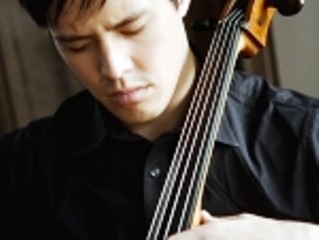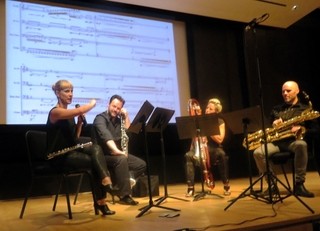|
Back
ICE and Iceland New York
Bruno Walter Auditorium, New York Library for Performing Arts
09/15/2016 -
Anna Thorvaldsdottir: Sequences (World premiere) – Transitions
Members of International Contemporary Ensemble (ICE): Michael Nicolas (Cello), Alice Teyssier (Bass Flute), Campbell Macdonald (Bass Clarinet), Ryan Muncy (Baritone Saxophone), Rebekah Heller (Contrabassoon)
Ross Karre (Compere)

A. Thorvaldsdottir (© Saga Sigurdardottir)
The stunningly original composer Anna Thorvaldsdottir is so acclaimed internationally that she hardly needs to have her own musicians. But for three years now, the International Contemporary Ensemble (ICE) has been her chamber group of choice. The 30-odd musicians of ICE, amongst the masters of contemporary music, have made the journey to Ms. Thorvaldsdottir’s native Iceland several times a year. There they walk with her, speak about her ideas, (perhaps over their famous fermented fish and venomous vodka), and–most essential of all–work within her splendid orbit of musical ideas.
When two or her works for ICE were played last night in the Bruno Walter Auditorium of the New York Public Library, the event became a symposium of kinds. The first work, for solo cello, was played without introduction by the musician for whom it was written. After this, though, the personable ICE percussionist, Ross Karre, interviewed cellist Michael Nicolas, with fairly deep (though hardly technical) questions about his relations with the composer, with the music, with the meaning of the Transitions itself.
After this, Mr. Nicolas repeated the work, generating more information–and perhaps to find new nuances, new layers to its repetition.
Mr. Karre moderated a more augmented introduction to the world premiere of Transitions, including a video interview with Ms. Thorvaldsdottir, the performance, a conversation with the four musicians, questions from the audience, and yes, a repeat of the fairly short work.
ICE, then, was giving more than music for this first concert of the NYPL season. They were giving us insights into the musicians, and perceptions into the mind of its ultimate creator, Anna Thorvaldsdottir.
And that was the key. Ms. Thorvaldsdottir is performed here regularly, and while one could airily say the music is “beautiful,” it was refreshing to hear about her inspirations, her work with the musicians, and the musical text behind the notes.

M. Nicolas (© Courtesy of the Artist)
It might have been enough for Michael Nicolas to give us a slow-moving but transparent solo cello piece. Mr. Nicolas is one of the masters of all things cellistic. Yet in this case, while we heard the clicks on the soundboard, the harmonics, the microtonal phrasing, the reverberations and silences in 11 minutes of the most magical playing, we heard–both before and after the interview with Mr. Karre–something more elegiac.
Unlike so much contemporary music, nothing was frantic here, nothing was on the cusp of violence. As was explained, Transitions dealt with the contrasts of humankind and machine. And yes, Mr. Nicolas, from the almost inaudible beginning to the long chords at the end, played with a lyrical, virtually cantabile feeling here–albeit with those clicks, those reverbs etc possibly implying “machine.”
But was Ms. Thorvaldsdottir judging the “machine” as the enemy? I don’t believe that for a moment. Mr. Nicolas gave it the sounds of a non-human androidal...er, creature. Yet those sounds were part of the whole. As if, instead of extolling her blessed Icelandic nature, she was allowing the inevitable, those alien sounds, to be part of the same canvas.
And canvas is the word. Ms. Thorvaldsdottir is a sound painter. (I was tempted to say an ice-sculptor, but Iceland is greenish, while Greenland is ice-ish. Go figger.) And nowhere was that better shown than this first performance of Sequences.

A. Teyssier, C. Macdonald, R. Heller, R. Muncy (© Samuel A. Dog)
The instrumentation was...well, low: all bass instruments. Rebeccah Heller on contrabassoon, Ryan Muncy on baritone saxophone, Cambell Macdonald playing bass clarinet. Trying to blend in was Alice Teyssier playing bass flute. Though, inevitably, this was a descant, a solo above the rest.
One person on the audience said it resembled the sounds of an organ. But while this trio of bass instruments played slowly (64 beats per minute, according to the score), the colors of the mass sounds hardly had the monolithic organ sounds. Microtonal phrases, gentle interweavings of sax and bassoon and clarinet, an unusual lightness. Ms. Teyssier’s bass flute was far above the rest, but her phrasings, her cellular motives gave what seemed like an impetus to the others.
I confess to having my own image of the music, since the interview with Ms. Thorvaldsdottir showed what seemed like an 18th Century naturalist’s drawing of a branch, tendrils blooming. Thus, when the first minute of the work had the four players contrapuntally exhaling over different notes, it gave the picture of a wind blowing...then a single note, organically growing over the entire piece, until a final exhalation. And I saw Ms. Thorvaldsdottir showing a musical version of biological growing.
One would like to say that the music was its own reward. But the visual imagination was irresistible. And one doubts that the composer would rebel at such thoughts.
For outside of that picture, this was, like Sequences, an aural painting. Whether one saw a Rothko set of colors slowly journeying over the landscape, or the wanderings of a creative soul over the ancient plains of Iceland, Ms. Thorvaldsdottir had created a world fusing her mind, her environment and her spirit.
Harry Rolnick
|